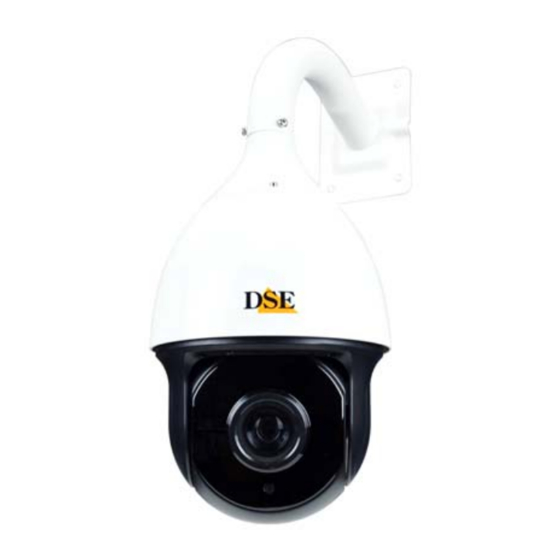DSE SD-5 Series Manuale d'uso - Pagina 3
Sfoglia online o scarica il pdf Manuale d'uso per Fotocamera digitale DSE SD-5 Series. DSE SD-5 Series 15.

USER MANUAL
SPEED DOME CAMERAS SD-xxx-5
Page:3
INSTALLING THE CAMERA
SD series cameras are carefully packed to prevent
damage in transit. First of all, it is necessary to check
the material received. The speed dome camera you
have purchased is protected by packing elements which
must be carefully removed before using it.
Realization
with command from RS485
A cable with the following connections comes out of an
SD Series Speed Dome camera:
112VDC power supply with 5.5 mm plug.
Video outputBNC female
2 CablesBUS RS485 YELLOW (A +) / ORANGE (B-)
To structure a Speed Dome camera system, 3 types of
cabling must be prepared:
Diet. It is possible to power the camera locally with
a 220VAC / 12VDC adapter of at least 3A (not supplied)
or arrange a 12VDC network with cables of adequate
section in order to avoid excessive voltage drops.
Video
connection.It
traditional analog CCTV camera. The video signal
produced by this camera can be set to composite video
CVBS or AHD / CVI / TVI depending on the DVR to be
connected to, but there are no differences in the type
of cabling of these two technologies. RG59 coaxial
cable is generally used for distances up to 2-300
meters. It is also possible to carry the video signal on
twisted pairs using special converters (RE-BNCRJ1) up
to about 200 m. The twisted pair converters are also
available in the active version to reach distances over
200 m.
Telemetry.This
is
conducts motion commands to the camera. The SD
series cameras use an RS485 serial line (BUS RS485)
which must be created with a pair of twisted cables. It
is essential that the 2 cables are wound together and
not parallel. Theoretically, the RS485 serial line can
extend up to 1200 meters in length and the devices are
of
the
wiring
is
realized
as
for
the
serial
connection
connected in cascade along it. The section of the cables
strictly depends on the length of the connection: for
medium distances a section of 0.5 mm is sufficient,
while if it is necessary to reach considerable distances
(max. 1200 m.), Higher sections of 1 mm or even 2.5
mm must be used. When carrying out the wiring, it is
advisable, but not essential, to use a shielded cable.
The CAT5 network cable,
The cameras and consoles must be connected in
cascade, i.e. entering and exiting the 2 terminals
RS485A and RS485B. It is important not to invert the
two cables (AB) when connecting the equipment.
The order in which the devices are connected to the
BUS does not matter. Each device will be identified by
its
own
unique
microswitches, which will allow the instructions to be
correctly addressed. Up to 256 cameras can be
connected to the same BUS. The consoles do not
require any addressing, while for the cameras it is
necessary to set a different address for each camera,
as described below.
Realization of wiring with
UTC
command
cable
If you have a UTC controlled DVR, such as our RK
Series DVRs, you can send commands to the camera
over the video cable without having to wire the twisted
pair. To use this command, UTC must be selected as
the protocol in the NVR instead of Pelco D. The RS485
connectors are left unused.
Note that if the camera receives commands via UTC,
some functions may not be usable with respect to the
RS485 connection.
Command bodies
any
The movements of these cameras are controlled via the
common PELCO P / D protocol, now a consolidated
industry standard. It is possible to send the commands
with the special consoles for speed dome cameras or
through the DVRs equipped with RS485 port.
UTC-controlled DVRs can control these motorized
cameras with just the video cable
Address, protocol and Baud
Rate
that
After connecting the camera, it is necessary to set the
communication parameters so that it is able to
communicate with the control units.
All the elements of the RS485 BUS, both cameras and
control units, must use the same protocol (PELCO D
WWW.DSE.EU
address,
which
can
be
on
set
via
video
